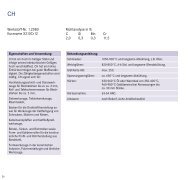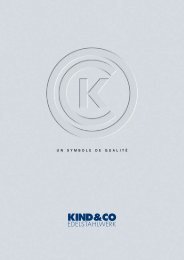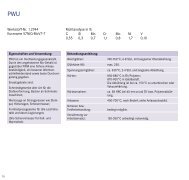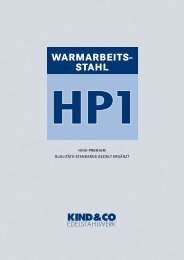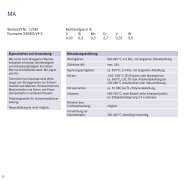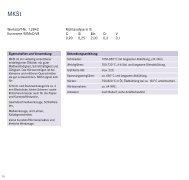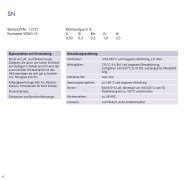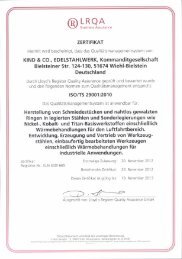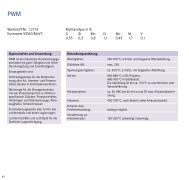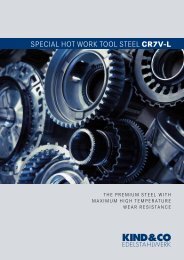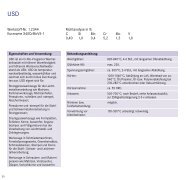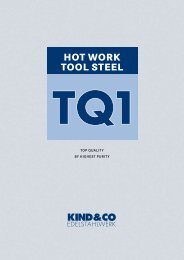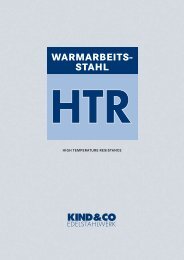ToolingS FoR ExTRuSion pRESSES - Kind & Co., Edelstahlwerk, KG
ToolingS FoR ExTRuSion pRESSES - Kind & Co., Edelstahlwerk, KG
ToolingS FoR ExTRuSion pRESSES - Kind & Co., Edelstahlwerk, KG
Create successful ePaper yourself
Turn your PDF publications into a flip-book with our unique Google optimized e-Paper software.
<strong>ToolingS</strong> <strong>FoR</strong> <strong>ExTRuSion</strong> <strong>pRESSES</strong>
For more than 120 years tool steels and<br />
their applications have shaped our<br />
company. Experience and the most<br />
advanced technological equipment<br />
from primary steel melting to the<br />
ready-to-use toolings is the basis of the<br />
products of KIND & CO which are<br />
well excepted all over the world.<br />
S e r v i c e f r o m o n e S i n g l e S o u r c e<br />
Todays economic importance of the<br />
extrusion technology was furthered not<br />
only by technical developments on the<br />
equipment side but also by constant<br />
development on the tooling side. To us,<br />
the growing requirements of our customers<br />
provide the impetus for our work.<br />
The purpose of this documentation is<br />
to serve as a brief guide and to give a<br />
summary of recent developments of<br />
toolings for extrusions presses.
i n D i r e c t a n D D i r e c t e x t r u S i o n<br />
©KM Europa Metal Ag, osnabrück<br />
indirect extrusion<br />
Indirect extrusion has meanwhile found<br />
acceptance for producing wire, rods,<br />
and sections from brass. Also for<br />
extruding high-alloyed aluminium<br />
indirect extrusion is often the preferred<br />
solution. <strong>Co</strong>mpared with direct extrusion,<br />
the special material flow of indirect<br />
extrusion facilitates higher extrusion<br />
rates. No friction between billet and<br />
inner liner and therefore no friction heat<br />
can occur, results in homogeneous<br />
material properties along the entire<br />
length of the extruded strand.<br />
Direct extrusion<br />
Preferred application for manufacturing<br />
copper products using the underwater<br />
extrusion method to achieve low-oxide<br />
surfaces. Large section circumferences<br />
and asymmetrical hollow shapes can be<br />
easily direct extrude for the aluminium<br />
industry.
f r o m D e S i g n t o p r o j e c t i n t e g r a t i o n<br />
Based on a set of requirements defined<br />
by the plant operator or manufacturer,<br />
we conceive ultra modern tool packages<br />
such as containers, stems, mandrels<br />
and dummy blocks.<br />
<br />
The new designs are not only based on<br />
theoretical considerations but, due to<br />
years of maintenance and repair of containers,<br />
also on hands-on experience.<br />
Together with our customers' production<br />
expertise, a high-performance and<br />
<br />
modern 3D-CAD design is achieved.<br />
That‘s why <strong>Kind</strong> + <strong>Co</strong>. is also a reliable<br />
partner for the total modernisation of<br />
tooling systems.
1 2 3<br />
<br />
Extrusion stem<br />
Pressure disk<br />
Mantle<br />
Intermediate liner<br />
Inner liner<br />
Die<br />
1 Special surface topography<br />
(WT cooling*) for highly efficient cooling<br />
of air-cooled intermediate liners.<br />
2 Air protection (AP system**) to prevent<br />
cracks on air-cooled containers.<br />
3 Modern 3D-CAD design of a container<br />
with integral zone heating/cooling system.<br />
4 Development and modernization of<br />
customized holders and containers.<br />
5 KCPC*** Smart development in heating<br />
connections - largely eliminates the possibility<br />
of stress cracks forming.<br />
* Registered design no. 201 17 589.4 (GER)<br />
** Registered design no. 203 18 917.5 (GER)<br />
** Registered design no. GM 874 2003 (AUT)<br />
*** Registered design no. 102008 021 226.1 (GER)<br />
4<br />
5
m a t e r i a l S : a n a l y S i S & p r o p e r t i e S<br />
overview of the most important materials for extrusion toolings<br />
Dominial grade Din Standard AiSi AFnoR Reference analysis %<br />
Yield point Rp0.2 in n/mm 2<br />
1400<br />
1200<br />
1000<br />
800<br />
600<br />
400<br />
200<br />
0<br />
300<br />
400 500 600 700 800<br />
C Cr Mo ni V W <strong>Co</strong> other<br />
KTW 1. 11 0CrMnMo7 ~ P 0 0CMD8 0. .00 0. 0 – – – – Mn 1. 0<br />
CM 1 7 1. 8CrMoV -7 – CDV 0. 1. 0 0.7 – 0. 0 – –<br />
USN 1. X 7CrMoV -1 H 11 Z 8CDV 0. 7 . 0 1. 0 – 0. 0 – –<br />
USD 1. X 0CrMoV -1 H 1 Z 0CDV 0. 0 . 0 1. 0 – 1.00 – –<br />
RP 1. CrMoV -1 – DCV1 - 8 0. .00 .80 – 0. 0 – –<br />
RPU 1. 7 X 8CrMoV - – Z 8VDV - 0. 8 .00 .00 – 0. 0 – –<br />
HP1* – – – – 0. . 0 1. 0 – 0. – – Nb +<br />
Q10/TQ1* – – – – 0. . 0 1.90 – 0. – –<br />
HWD** 1. 78 X <strong>Co</strong>CrWV - - H 19 Z 0KCWV0 -0 -0 0. 0 . 0 0. 0 – .10 . 0 . 0<br />
PWM 1. 71 NiCrMoV7 ~ L ~ NCDV7 0. 1.10 0. 1.70 0.10 – –<br />
MA-Rekord** 1. 7 8 X 0WNiCrV<strong>Co</strong>1 -1 – – 0. .00 0. 0 11. 0 1.10 1 .00 1. 0<br />
RP<strong>Co</strong>** 1. 88 X CrMo<strong>Co</strong>V - - H 10A – 0. .00 .80 – 0. 0 – .00<br />
RM 10 <strong>Co</strong>** 1. 888 X 0<strong>Co</strong>CrWMo10-9 – – 0. 0 9. 0 .00 – – . 0 10.00<br />
HMoD** 1. 889 X <strong>Co</strong>CrMo - - H 19A – 0. . 0 .00 – .00 – . 0<br />
HWF** 1. 779 X NiCrTi -1 A 8 Z NCTDV 1 B < 0.08 1 .00 1. 0 .00 – – – Ti . 0<br />
Sa 718** . 8 NiCr19Fe19Nb Mo UNS<br />
No<br />
7718<br />
NC19FeNb 0.0 19.00 .00 .00 – – – Nb .0<br />
Ti 0.9<br />
Al 0.<br />
SA 0 Ni** . 97 NiCr19<strong>Co</strong>Mo R 1 – < 0.1 19.00 9. 0 Rest<br />
Balance<br />
100<br />
90<br />
80<br />
70<br />
60<br />
50<br />
40<br />
30<br />
20<br />
10<br />
0<br />
300<br />
Test temperature in °C Test temperature in °C<br />
percentage reduction of area Z<br />
– – 11.00 Ti .0<br />
Al 1.<br />
* produced using electroslag remelting (ESR) ** exclusively for heavy metal extrusion<br />
M = martensitic A = austenitic ni = nickel based alloy<br />
400 500 600 700 800
<strong>Co</strong>mparison of properties of major materials<br />
Light metal processing<br />
USN<br />
USD<br />
RPU<br />
HP1<br />
Q10<br />
TQ1<br />
USN<br />
USD<br />
RPU<br />
HWF<br />
SA 718<br />
SA 50 Ni<br />
USN<br />
USD<br />
RPU<br />
HP1<br />
Q10<br />
TQ1<br />
High temperature strength High temperature toughness High temperature wear resistance<br />
Heavy metal processing<br />
HP1<br />
Q10<br />
TQ1<br />
USN<br />
USD<br />
RPU<br />
RM 10 <strong>Co</strong> RM 10 <strong>Co</strong><br />
HWF<br />
SA 718<br />
SA 50 Ni<br />
USN<br />
USD<br />
RPU<br />
HP1<br />
Q10<br />
TQ1<br />
USN<br />
USD<br />
RPU<br />
HP1 HP1<br />
Q10<br />
TQ1<br />
Q10<br />
TQ1<br />
RM 10 <strong>Co</strong><br />
High temperature strength High temperature toughness High temperature wear resistance<br />
HWF<br />
SA 718<br />
SA 50 Ni<br />
High temperature strength High temperature toughness High temperature wear resistance<br />
Typical annealing structure<br />
of a hot-work steel<br />
Typical tempering structure<br />
of a hot-work steel<br />
Typical structure of<br />
age hardened austenite<br />
Typical structure<br />
of a nickel base alloy<br />
7
8<br />
m a t e r i a l S f o r e x t r u S i o n t o o l i n g S<br />
<strong>Co</strong>ntainer technology light metal Heavy metal<br />
Mantle<br />
intermediate<br />
liner<br />
inner liner<br />
load pspec. KinD + <strong>Co</strong> brand grade KinD + <strong>Co</strong> brand grade<br />
low<br />
high<br />
low<br />
high<br />
(air cooling)<br />
low<br />
(‹600 n/mm 2 )<br />
high<br />
(›600 n/mm 2 )<br />
PWM<br />
KTW<br />
USN<br />
USD<br />
USN<br />
USD<br />
USN<br />
RPU<br />
Q10<br />
USN<br />
USD<br />
RP<br />
RPU<br />
Q10<br />
USN<br />
RPU<br />
TQ1<br />
Q10<br />
HP1<br />
1. 71<br />
1. 11<br />
1.<br />
1.<br />
1.<br />
1.<br />
1.<br />
1. 7<br />
–<br />
1.<br />
1.<br />
1.<br />
1. 7<br />
–<br />
1.<br />
1. 7<br />
–<br />
–<br />
–<br />
PWM<br />
USN<br />
USN<br />
RPU<br />
USN<br />
USD<br />
Q10<br />
RPU<br />
Q10<br />
RP<br />
RPU<br />
HWF<br />
RM 10 <strong>Co</strong><br />
HWF<br />
SA 718<br />
1. 71<br />
1.<br />
1.<br />
1. 7<br />
1.<br />
1.<br />
–<br />
1. 7<br />
–<br />
1.<br />
1. 7<br />
1. 779<br />
1. 888<br />
1. 779<br />
. 8<br />
Extrusion stem light metal Heavy metal<br />
load pspec. KinD + <strong>Co</strong> brand grade KinD + <strong>Co</strong> brand grade<br />
low<br />
(‹600 n/mm2 )<br />
USN<br />
USD<br />
1.<br />
1.<br />
USN<br />
RP<br />
RPU<br />
1.<br />
1.<br />
1. 7<br />
high<br />
(›600 n/mm2 USN<br />
1.<br />
USN<br />
1.<br />
)<br />
RPU<br />
TQ1<br />
Q10<br />
1.<br />
–<br />
–<br />
7<br />
RPU<br />
TQ1<br />
Q10<br />
1.<br />
–<br />
–<br />
7<br />
HP1<br />
–<br />
HP1<br />
–<br />
Tooling light metal Heavy metal<br />
KinD + <strong>Co</strong> brand grade KinD + <strong>Co</strong> brand grade<br />
USN<br />
1.<br />
RP<br />
1.<br />
Sealing plate<br />
USD<br />
1.<br />
RPU<br />
1. 7<br />
RPU<br />
1. 7<br />
SA 718<br />
. 8<br />
USN<br />
1.<br />
RP<br />
1.<br />
Die holder<br />
RPU<br />
1. 7<br />
RM 10 <strong>Co</strong><br />
1. 888<br />
SA 718<br />
. 8<br />
USN<br />
1.<br />
USN<br />
1.<br />
Mandrel<br />
USD<br />
RPU<br />
1.<br />
1. 7<br />
USD<br />
RP<br />
1.<br />
1.<br />
Q10<br />
–<br />
RPU<br />
1. 7<br />
Mandrel tip<br />
SA 718<br />
SA 0 NI<br />
. 8<br />
. 97<br />
USN<br />
1.<br />
HDW<br />
1. 78<br />
USD<br />
1.<br />
MA-Record 1. 7 8<br />
Dies<br />
RPU<br />
TQ1<br />
Q10<br />
1.<br />
–<br />
–<br />
7<br />
HWF<br />
RM 10 <strong>Co</strong><br />
HMoD<br />
1. 779<br />
1. 888<br />
1. 889<br />
HP1<br />
–<br />
Stellit / Stellit / MHC
10<br />
H e a t t r e a t m e n t – t H e w a y t o p r o v i D e<br />
t H e r e q u i r e D t o o l p r o p e r t i e S<br />
Achieving the best material properties<br />
is the key for dependability and maximum<br />
life time.<br />
The most advanced vacuum hardening<br />
and nitriding furnaces, an integrated<br />
quality assurance system as well as<br />
experience and know-how ensure the<br />
repeat accuracy heat treatment.<br />
Defined material properties are certificated<br />
by sampling in our own testing<br />
laboratory. Processing only takes place<br />
once the required features have been<br />
confirmed.<br />
A modern process control system<br />
ensures continuous monitoring and<br />
documentation of the complete<br />
manufacturing process.<br />
Special heat treatment such as partial<br />
annealing of tools (stem base/thread<br />
on the mandrel) or special surface<br />
treatments (nitriding/oxidising)<br />
complete our range of services in the<br />
field of heat treatment.<br />
Power unit Max. loading dimensions Max. heat weight Max. quenching<br />
L x W x H mm pressure<br />
Vacuum hardening 1, 00 x 1,000 x 1,000 , 00 kg 1 bar<br />
furnace 1, 00 x 1,000 x 1,000 ,000 kg bar<br />
Ø 1,000 x 1,800 ,000 kg bar<br />
900 x 10 x 10 00 kg 10 bar<br />
Nitriding furnaces 1, 00 x 1,000 x 1,000 , 00 kg<br />
1, 00 x 900 x 800 1, 00 kg<br />
910 x 10 x 10 00 kg
Nitriding of aluminium dies<br />
with white layer ( – 10 µm) and<br />
diffusion layer (0.10 – 0.1 mm)<br />
Nitriding furnace, index controlled<br />
Index controlled oxidising<br />
(metal oxidising / MO) of mandrels<br />
from heavy metal ( – µm)<br />
Quenching of a mantle in a polymer bath<br />
Hardening of extrusion stem<br />
Vertical loading for low-distortion vacuum hardening<br />
11
1<br />
S e r v i c e c H e c k<br />
o n c o n t a i n e r S<br />
The single components<br />
of each container<br />
such as the<br />
mantle, intermediate<br />
liner or inner liner are<br />
subject to a load situation which<br />
requires – sooner or later – replacing<br />
the liners. When carrying out this work,<br />
each container is completely inspected<br />
in order to decide on its further use or<br />
the need for any additional activities.<br />
Our service team includes qualified<br />
experts who are competent in the field<br />
of metallography, quality control,<br />
machining and sales.<br />
Inspection of critical points<br />
using the magnaflux method<br />
In addition to general tests, a detailed<br />
inspection of the sensitive holes for<br />
temperature sensors and air supply<br />
using a boroscope has become an<br />
important preventive activity.<br />
All test results and actions taken are<br />
stored in a database so that a comprehensive<br />
history of the containers can be<br />
provided and further technical developments<br />
can be worked out together<br />
with the customers. These practical<br />
experi-ences are the bench mark for<br />
the design of new containers and lead<br />
into enhanced tool life using detailed<br />
modificati-ons, e.g., WT cooling or AIR<br />
protection.<br />
Internal stability check<br />
Boroscope diagnostics with digital recording<br />
Supercooled shrinking of inner liner with double shoulders<br />
r e l i n i n g /<br />
S H r i n k i n g<br />
During operation, the container is subjected<br />
to strongly fluctuating mechanical<br />
and thermal loads.<br />
Application-specific load calculations<br />
take into account the press power, the<br />
container and billet temperatures as<br />
well as shrinkage strain. It is important<br />
that the various expansion coefficients<br />
of the materials are taken into account.<br />
Shrinking requires profound experience<br />
and extensive process technology to<br />
achieve the required parameters as well<br />
as the engineering solutions.<br />
Shrinking of a cooled intermediate<br />
bushing in a preheated jacket
S e r v i c e f r o m a t o z<br />
Basic inspection and assessment of usability:<br />
<strong>Co</strong>mponent dimensions<br />
Heating<br />
Cracks<br />
Hardeness<br />
Damages<br />
Integration of activities resulting<br />
from diagnostics<br />
Production release by the<br />
customer in case of a new design<br />
Boroscope examination<br />
on containers<br />
Identification<br />
Design<br />
Loading in a database<br />
Results of diagnostics and discussion with the customer:<br />
Replacement of liners<br />
Repair by welding<br />
optimized proposal/development:<br />
Material selection<br />
Determination of wall thickness<br />
<strong>Co</strong>oling<br />
Heating<br />
Temperature measurement<br />
Temperature control system<br />
order processing:<br />
order completion:<br />
Final inspection<br />
Inspection sheet/shrinkage<br />
”Air Protection” (AP) retrofit<br />
Repair of the heating system<br />
AP Air Protection<br />
WT heat exchanger technology<br />
Database evaluation<br />
Preparation of<br />
drawings/optimization<br />
Repair/new production<br />
of components including<br />
assembly<br />
Acceptance certificate<br />
Delivery/despatch<br />
1
1<br />
l i S t o f D i a g n o S t i c<br />
r e S u l t S<br />
Typical failure reasons on extrusion toolings:<br />
1<br />
2<br />
3<br />
4<br />
5<br />
6<br />
7<br />
8<br />
9<br />
10<br />
11<br />
12<br />
Cracks in heating pockets can be eliminated<br />
by design changes.<br />
Avoidance of threaded holes in the heating<br />
pockets.<br />
Softening (diagram) and plastic deformation<br />
on the container.<br />
Excessive surface pressure on flat sealing<br />
of the inner liner – flame marks at inner liners.<br />
Cracks in air supply holes of cooled containers<br />
are today prevented using the AP system*.<br />
Damaged mantle due to defective<br />
resistance heating element.<br />
<strong>Co</strong>mpression of extrusion stem is prevented<br />
using tough TQ1 material.<br />
Critical transitions on stems should be<br />
mitigated by design changes and by using<br />
superior materials (TQ1/Q10).<br />
<strong>Co</strong>ntraction and the presence of scaly surface<br />
on mandrels at heavy metal extrusion.<br />
Surface softening and lack of lubrication on<br />
mandrels during extruding copper tubes.<br />
Multiple nitriding treatments lead to excessive<br />
nitriding of the die surface (flaking).<br />
Plastic deformation and deflection at AL dies<br />
can be reduced using tough TQ1 material.<br />
* Registered design no. 203 18 917.5 (Germany)<br />
* Registered design no. GM 874 2003 (Austria)<br />
1<br />
2<br />
3<br />
4<br />
Stability in N/mm 2<br />
1400<br />
1300<br />
1200<br />
1100<br />
1000<br />
900<br />
800<br />
700<br />
600<br />
500<br />
Stability check using Equo Tip, converted into N/mm 2<br />
Local radial expansion jacket bore Ø d = 9 mm<br />
Local radial expansion intermediate bushing Ø d = . mm<br />
Intermediate bushing Ø D<br />
Intermediate bushing Ø d<br />
Jacket bore Ø d<br />
1 2 3 4 5 6 7 8 9 10<br />
Closing side<br />
Check points every 100 mm
5<br />
6<br />
7<br />
8<br />
9<br />
10<br />
11<br />
12<br />
1
www.kind-co.de<br />
More service<br />
Tool steels and<br />
special materials<br />
Melting<br />
Forging<br />
Ring rolling<br />
Heat treatment<br />
Machining<br />
Surface treatment<br />
KIND & CO., <strong>Edelstahlwerk</strong>, <strong>KG</strong><br />
Bielsteiner Str. 128-130 . D-51674 Wiehl-Bielstein<br />
Tel. +49 (0) 22 62 / 84-0 . Fax +49 (0) 22 62 / 84-175<br />
info@kind-co.de . www.kind-co.de a,k.09.08



